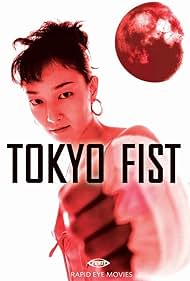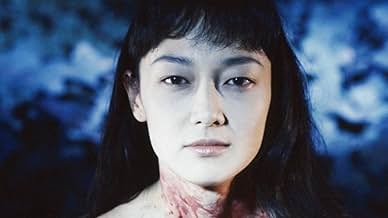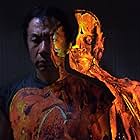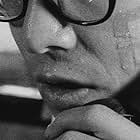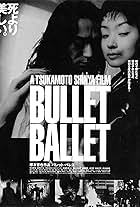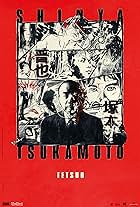IMDb RATING
7.0/10
4.2K
YOUR RATING
Suspecting that his childhood friend, a professional boxer, is having a love affair with his fiancée, a businessman starts training rigorously in order to take him down.Suspecting that his childhood friend, a professional boxer, is having a love affair with his fiancée, a businessman starts training rigorously in order to take him down.Suspecting that his childhood friend, a professional boxer, is having a love affair with his fiancée, a businessman starts training rigorously in order to take him down.
- Awards
- 2 wins & 2 nominations
Storyline
Did you know
- ConnectionsFeatures Metropolis (1927)
Featured review
Japanese film maker genius and multi-talent Shinya Tsukamoto's Tokyo Fist (Tokyo-ken, 1995) is as stunning and incredible experience as can be expected after seeing his two Tetsuo films in which a human body and metal (machine) became one with a horrific results. Tsukamoto's cinema is filled with hyper fast editing, shaking camera, fast forwards and every imaginable things to shock the viewer senses and make the weakest faint. Tokyo Fist is not any exception.
Director himself plays Tsuda, a nerdish Japanese insurance salesman who has a beautiful girlfriend Hizuru (Kahori Fujii) whom with he lives seemingly peacefully and in love. But still it looks like Tsuda has some problems in his life and seems to be on the edge of his sanity. Soon his high school time friend Kojima arrives (played by the director's brother, Kôji Tsukamoto) and he is a professional boxer and very fierce one. When he starts to be interested in Tsuda's girl, all physical and mental hell breaks loose as Tsuda gets an obsession to start to box himself, too, and Hizuru starts to have some very severe habits of body piercing and self mutilation. The infernal ride has begun and the viewer is not recommended to take it granted that he'll/she'll stomach the ride till the end because this is Tsukamoto. That means incredible power and impact straight to your face.
The film is perhaps even wilder at some points than the first Tetsuo (1988) as the message and imagery is really heavy this time and the film is in color, too. The fists, the punches and the mayhem is always aimed straight to the camera, the viewer and audience, so the viewer will be on the edge of the seat for the whole time, and it all is of course at its most powerful when seen on the big screen. Tsukamoto has the talent to hammer and force his things to the skull and spinal cord of the viewer and he does it all with the magic of editing and cinematography, and definitely not least of Chu Ishikawa's pounding and merciless soundtrack which is here as effective and wonderful as in Tetsuo.
The visuals are impressive and every twisted camera angle has its purpose and meaning as well as every bit of mist and darkness that is shed during the ride. The effect when he shakes his camera is something truly unique and definitely much more powerful way to depict the feelings and mental states of the characters than any dialogue ever could. Fast edits and unconventional usage of camera can be very irritating and needless when used without any real reason or to make the film look "stylish", but they can also be heart stoppingly effective when they have a cinematic meaning and the director could just simply write on the paper what the edit or camera angle means inside the film. Tetsuo is another great example of this and its black and white scenery is no less powerful than the colors in Tokyo Fist. Tokyo Fist is extremely menacing as there hardly are any peaceful moments and there's all the time some element there to make it clear that it is not peaceful even though it may look like it.
The film's theme is about human nature and its jealous and weak sides as the characters can't live without taking or producing physical pain. The smashed faces and the scenes of surreal gore spurting at nightmarish anger are really something to make us ask why do the characters do it. Why cannot human nature solve things in other way than physical force and violence and how many of us dares to admit the brute sides of ourselves and accept them? And then of course keep them away and on the background. The final image is kind of "optimistic" but definitely no character gets out without the result and payment of their deeds. The film is also a good example for those who think that in Japanese cinema females are often on the background and weaker than men as the lead female in Tokyo Fist practically (and quite passively!) makes, at first so powerful and dominating, Kojima as her submissive slave.
The film begins as in our familiar world in modern day Japan but it is not so long before Tsukamoto gives us the first glimpses of his surreal visions that are taken at their extremes in the incredible blood soaked nightmare finale "in the ring", a finale that is so fierce, kinetic and merciless piece of film making it just makes me appreciate and love Japanese cinema even more with its many sides never or very rarely paralleled in other world cinema. The gore and violence is sudden and almost unbearably shocking at times but the blood geysirs are not realistic nor they're meant to be; they are from the film's own world and as symbolic and surreal as in the Japanese samurai classic The Baby Cart aka Lone Wolf & Cub series in the early seventies, the first two parts of that series edited also into one feature film as Shogun Assassin (1980). Still none of these films manages to give the kind of impact in their violence or any other element than Tokyo Fist, but the surreal depiction of physical violence is pretty similar with Tsukamoto and The Baby Cart pieces.
Perhaps only negative point I can find in Tokyo Fist is that some of the characters seem to develop a little too fast and they should have been little more motivated and restrained. For example, Tsuda seems to be completely mad already and is capable to rape his girlfriend any time so these kind of things should be explained little more carefully in order to make the piece perfect and the characters more real. Still the characters are very good and the message and theme gets delivered very effectively through their acts and there's absolutely no question that the visual magic and impact of Tsukamoto's deserves nothing less than praising and moments of pure amazement.
Shinya Tsukamoto is the kind of Master of Cinema that he really deserves his name in the thanks section of the end credits of every young film maker's film who has got inspiration from his work. His films have the ability to make people faint, shock, turn the head off the screen and stun in their power and it all is done practically by himself as he works as an editor, cinematographer, art director etc. in his own films and thus expresses his visions. His films would be totally unforgettable when seen at least once in the big screen but fortunately the effect is still very strong on television, too. Tokyo Fist is among the most fierce, angry and honest rides of cinema I've ever experienced and everytime I see something from its maker, I cannot help but feel confused and amazed in front of Japan and its invaluable gifts during the centuries to the world of cinema.
9/10
Director himself plays Tsuda, a nerdish Japanese insurance salesman who has a beautiful girlfriend Hizuru (Kahori Fujii) whom with he lives seemingly peacefully and in love. But still it looks like Tsuda has some problems in his life and seems to be on the edge of his sanity. Soon his high school time friend Kojima arrives (played by the director's brother, Kôji Tsukamoto) and he is a professional boxer and very fierce one. When he starts to be interested in Tsuda's girl, all physical and mental hell breaks loose as Tsuda gets an obsession to start to box himself, too, and Hizuru starts to have some very severe habits of body piercing and self mutilation. The infernal ride has begun and the viewer is not recommended to take it granted that he'll/she'll stomach the ride till the end because this is Tsukamoto. That means incredible power and impact straight to your face.
The film is perhaps even wilder at some points than the first Tetsuo (1988) as the message and imagery is really heavy this time and the film is in color, too. The fists, the punches and the mayhem is always aimed straight to the camera, the viewer and audience, so the viewer will be on the edge of the seat for the whole time, and it all is of course at its most powerful when seen on the big screen. Tsukamoto has the talent to hammer and force his things to the skull and spinal cord of the viewer and he does it all with the magic of editing and cinematography, and definitely not least of Chu Ishikawa's pounding and merciless soundtrack which is here as effective and wonderful as in Tetsuo.
The visuals are impressive and every twisted camera angle has its purpose and meaning as well as every bit of mist and darkness that is shed during the ride. The effect when he shakes his camera is something truly unique and definitely much more powerful way to depict the feelings and mental states of the characters than any dialogue ever could. Fast edits and unconventional usage of camera can be very irritating and needless when used without any real reason or to make the film look "stylish", but they can also be heart stoppingly effective when they have a cinematic meaning and the director could just simply write on the paper what the edit or camera angle means inside the film. Tetsuo is another great example of this and its black and white scenery is no less powerful than the colors in Tokyo Fist. Tokyo Fist is extremely menacing as there hardly are any peaceful moments and there's all the time some element there to make it clear that it is not peaceful even though it may look like it.
The film's theme is about human nature and its jealous and weak sides as the characters can't live without taking or producing physical pain. The smashed faces and the scenes of surreal gore spurting at nightmarish anger are really something to make us ask why do the characters do it. Why cannot human nature solve things in other way than physical force and violence and how many of us dares to admit the brute sides of ourselves and accept them? And then of course keep them away and on the background. The final image is kind of "optimistic" but definitely no character gets out without the result and payment of their deeds. The film is also a good example for those who think that in Japanese cinema females are often on the background and weaker than men as the lead female in Tokyo Fist practically (and quite passively!) makes, at first so powerful and dominating, Kojima as her submissive slave.
The film begins as in our familiar world in modern day Japan but it is not so long before Tsukamoto gives us the first glimpses of his surreal visions that are taken at their extremes in the incredible blood soaked nightmare finale "in the ring", a finale that is so fierce, kinetic and merciless piece of film making it just makes me appreciate and love Japanese cinema even more with its many sides never or very rarely paralleled in other world cinema. The gore and violence is sudden and almost unbearably shocking at times but the blood geysirs are not realistic nor they're meant to be; they are from the film's own world and as symbolic and surreal as in the Japanese samurai classic The Baby Cart aka Lone Wolf & Cub series in the early seventies, the first two parts of that series edited also into one feature film as Shogun Assassin (1980). Still none of these films manages to give the kind of impact in their violence or any other element than Tokyo Fist, but the surreal depiction of physical violence is pretty similar with Tsukamoto and The Baby Cart pieces.
Perhaps only negative point I can find in Tokyo Fist is that some of the characters seem to develop a little too fast and they should have been little more motivated and restrained. For example, Tsuda seems to be completely mad already and is capable to rape his girlfriend any time so these kind of things should be explained little more carefully in order to make the piece perfect and the characters more real. Still the characters are very good and the message and theme gets delivered very effectively through their acts and there's absolutely no question that the visual magic and impact of Tsukamoto's deserves nothing less than praising and moments of pure amazement.
Shinya Tsukamoto is the kind of Master of Cinema that he really deserves his name in the thanks section of the end credits of every young film maker's film who has got inspiration from his work. His films have the ability to make people faint, shock, turn the head off the screen and stun in their power and it all is done practically by himself as he works as an editor, cinematographer, art director etc. in his own films and thus expresses his visions. His films would be totally unforgettable when seen at least once in the big screen but fortunately the effect is still very strong on television, too. Tokyo Fist is among the most fierce, angry and honest rides of cinema I've ever experienced and everytime I see something from its maker, I cannot help but feel confused and amazed in front of Japan and its invaluable gifts during the centuries to the world of cinema.
9/10
- How long is Tokyo Fist?Powered by Alexa
Details
- Release date
- Country of origin
- Languages
- Also known as
- Токийский кулак
- Production company
- See more company credits at IMDbPro
Contribute to this page
Suggest an edit or add missing content

